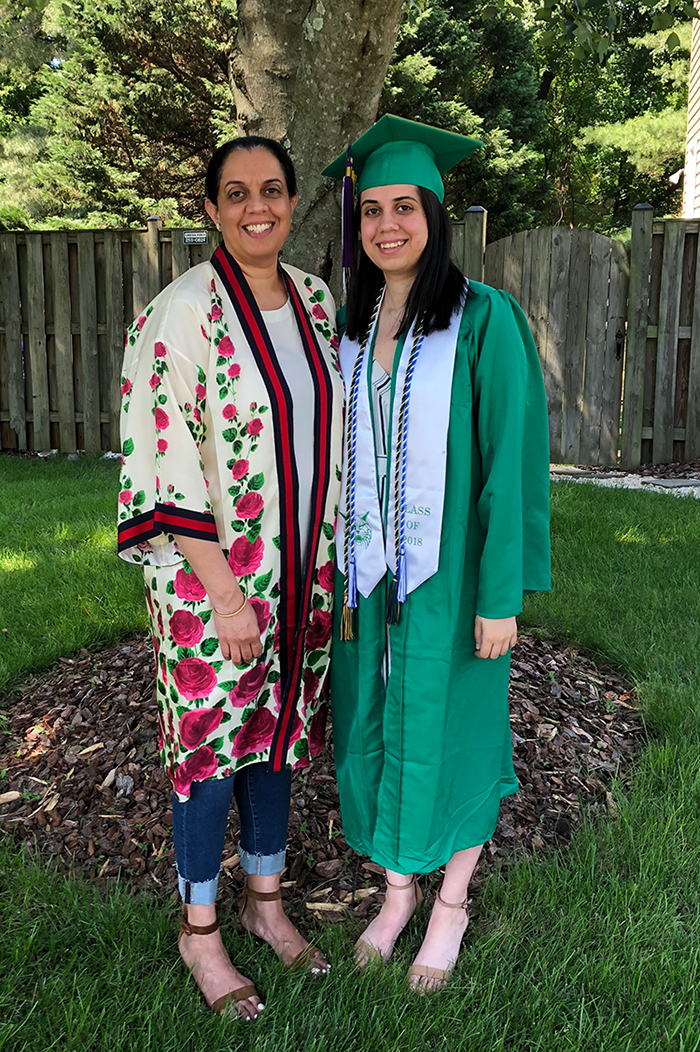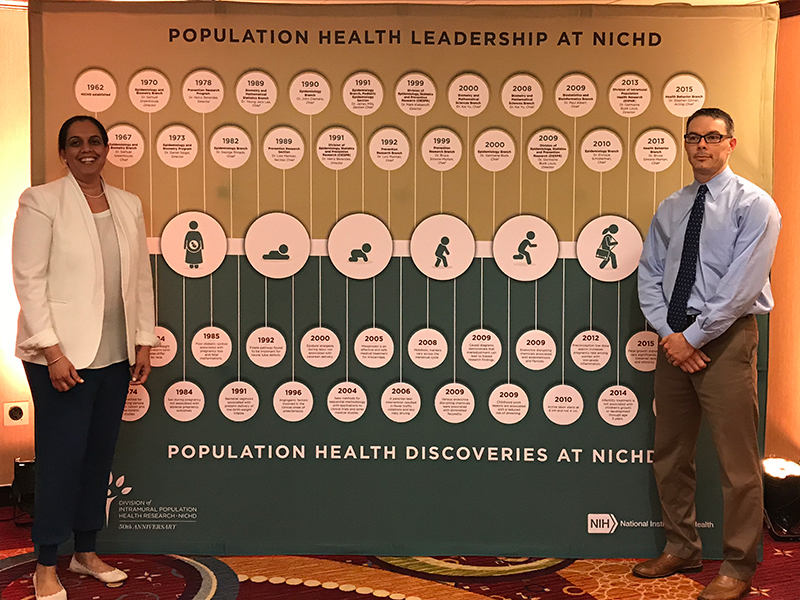
For NICHD’s Una Grewal, Ph.D., M.P.H., the best part of working at NIH is “being around people who are always pushing boundaries, asking bold questions, and trying to find the answers.” As director of NICHD’s Division of Population Health Research (DiPHR) within the Division of Intramural Research, Dr. Grewal oversees the work of 60 investigators and trainees who study health and disease outcomes in large populations, rather than in individuals, to inform medical practice and public policy.
“Una always challenges us by looking at each study with a critical eye, asking ‘How does this advance the field? How does this impact people’s lives? How is this meaningful?’” says Stephen Gilman, Sc.D., chief of DiPHR’s Social and Behavioral Sciences Branch.
Dr. Gilman and other colleagues describe Dr. Grewal as an effective leader with both great attention to detail and an ability to see the big picture. Her broad experiences in academia, the corporate world, and state and federal government agencies helped lead her to science administration. By embracing new opportunities throughout her career, Dr. Grewal charted her own path, culminating in her current role as DiPHR Director.
Early Emphasis on Equality
Dr. Grewal grew up in Kolkata, India, in an “intellectually thriving household” with a businessman father, journalist and social worker mother, and two younger brothers. Her parents ensured that all the siblings were afforded the same opportunities and faced the same expectations, from studying at the same schools and playing the same sports, to following the same household rules. “It was a very equal household,” she says. “In hindsight, I am amazed at my parents’ progressiveness and their ability to raise a family that did not abide by many of the Indian cultural norms that existed at the time.”
Keeping with this progressive spirit, Dr. Grewal’s parents encouraged her to seek education abroad. She came to the United States at age 19 to attend Smith College, an all-women’s liberal arts school in Northampton, Massachusetts, on a full scholarship.
Dr. Grewal reflects on her time at Smith as the most influential experience in her entire career. She arrived as a self-described “studious, serious, and exceedingly shy individual” and left four years later “still studious, serious, and career-driven—but no longer shy.” She credits the academic and social environment at Smith with giving her the ability to think independently and the confidence to stand behind her convictions. She received her Bachelor of Arts degree magna cum laude in economics in 1991.
From Economist to Epidemiologist
After graduation, Dr. Grewal worked for four years at National Economic Research Associates, an economic consulting firm based in White Plains, New York. Most of her projects involved U.S. utility companies as clients, focusing on quantitative analysis of regulatory matters under consideration by public service commissions. It was during this time that she met her husband, David Backer. In 1995, the couple moved to the Midwest, where both began graduate studies at the University of Michigan—Dr. Grewal in economics and her husband in political science.
After three years, having fulfilled all the degree requirements except for her dissertation, Dr. Grewal felt unsatisfied. She could not visualize the real-life applications of her academic studies in economics, or the potential of using her skills to make meaningful change in the world. A different avenue emerged through a research assistantship she arranged with two economics faculty members who had joint appointments at the University of Michigan School of Public Health (UM SPH). Dr. Grewal became acquainted with the field of epidemiology and its practical relevance to human health, and she decided to pivot and pursue a master’s degree in public health.
“People get scared that what you do when you are an undergraduate, or during the early stages of your career or graduate education, determines where you will end up eventually. That is not true,” Dr. Grewal says. “If you are patient and you are able to be flexible and willing to take a few risks, you can make anything out of your career that you would like.”
Though she recalls finding biology courses difficult at first, having not studied the topic since high school, her strong mathematics and statistics background eased her transition into the program and proved to be a distinguishing capability. She earned her M.P.H. in epidemiology in 2000 and completed her Ph.D. in epidemiological sciences in 2005, both from UM SPH. Her doctoral dissertation examined hormone fluctuations and their impact on bone density in women during perimenopause. She worked closely with MaryFran Sowers, Ph.D., the principal investigator of the Study of Women’s Health Across the Nation (SWAN) , and collaborators who were experts in social epidemiology and biostatistics. These experiences and the mentorship and support of Dr. Sowers were vital to Dr. Grewal’s subsequent choices of career paths.
Moving Coast to Coast
During Dr. Grewal’s graduate studies, she and her husband welcomed their daughter, Annika. The family relocated to California in August 2005, when her husband accepted a postdoctoral fellowship at Stanford University. Dr. Grewal opted to take some time off and concentrate on being a mother. After just two months, however, she found herself eager for the next professional challenge. She secured a postdoctoral position at the March of Dimes, conducting research as part of the California Birth Defects Monitoring Program in Berkeley.
About a year and half into Dr. Grewal’s postdoc, the March of Dimes stopped funding the program. Her mentors, Gary Shaw, Dr.P.H. , and Suzan Carmichael, Ph.D.
, drew her attention to an open staff scientist position at NICHD. Dr. Grewal applied and was offered the job. By then, her husband had joined the faculty at the College of William and Mary in Williamsburg, Virginia, and had been “commuting” back and forth to California. The entire family packed up and relocated to Maryland in August 2007. Dr. Grewal began working for Jun Zhang, M.D., Ph.D., then a senior investigator in NICHD’s Division of Epidemiology, Statistics, and Prevention Research (DESPR), the predecessor of DiPHR.
Landmark Research
Dr. Grewal played a lead role in designing and implementing the NICHD Fetal Growth Studies, an ambitious project to establish standards for fetal growth and size at different stages of pregnancy. Abnormal fetal growth can affect disease risk across the lifespan, yet no U.S. standards existed for measuring fetal growth by ultrasound. Conventional growth charts relied heavily on data collected during the 1980s from predominantly White women. The NICHD Fetal Growth Studies sought to define ultrasonographic standards applicable to the diverse and changing maternal population in the United States, including older, non-White, and different body-type mothers.
Specifically, Dr. Grewal was responsible for managing logistics across 12 U.S. study sites, at which 2,802 women with single pregnancies and 171 with twin pregnancies were enrolled in research cohorts from 2009 to 2013. The sites collected extensive data, including more than 2 million ultrasound images. She also developed her own sub-study, subsidized by funding secured from the NIH Office of Dietary Supplements, to examine nutrition and supplement intake during pregnancy.
“I really enjoy designing a study, coming up with all of the instruments to collect the data, ensuring that we have really good data to answer important questions, and engaging in real-time problem solving to resolve whatever hiccups we have along the way,” she says. One of those hiccups occurred in 2011, when Dr. Zhang left NICHD to return to China. Dr. Grewal’s responsibilities for the day-to-day management of the project greatly increased.
“Una was truly resourceful in helping us manage challenges in operationalizing the study,” says Deborah Wing, M.D., M.B.A., who served as a Fetal Growth Studies investigator at the University of California, Irvine, site. “There were lots of nuances to manage, and she did it remarkably well.”
The NICHD Fetal Growth Studies have left a lasting scientific legacy. Analyses of the data identified racial and ethnic differences in fetal growth and showed that up to 15 percent of fetuses of minority mothers were being misclassified as too small, as reported in 2015. Such misclassifications could lead women to receive unnecessary medical tests and experience stress when their pregnancies are actually on track. In 2016, the study team reported that nearly 40 percent of twins would be classified as too small based on standards for single fetuses. These and other findings from the studies led to the development of two publicly available online calculators that serve as tools to help healthcare providers estimate the expected growth of a given fetus. The wealth of data collected on both single and twin pregnancies, which the study team described in a 2018 article, continues to help scientists gain new insights into pregnancy and fetal growth.
Embracing New Experiences
In 2013, Dr. Grewal’s professional trajectory shifted yet again, when she was appointed as the deputy director of what was then called the Division of Intramural Population Health Research (DIPHR).
“Una is a big thinker with attention to detail, which is a very rare skillset,” says Germaine Buck Louis, Ph.D. , who was director of DIPHR at the time and now serves as dean and professor in the College of Health and Human Services at George Mason University. “She has the ability to manage up, down, and horizontally and to bring people together for even greater accomplishments.”
Dr. Grewal embraced the new opportunity and found that her enjoyment of project management translated well to a leadership role in science administration. As deputy director, she spent about 70 percent of her time on work related to the oversight and operation of the division and only 30 percent on scientific research activities—calling it “a pretty drastic change.” She learned most of the administrative aspects of her role while on the job.
“You have to be willing to throw caution to the wind and allow your career to be on autopilot just a little bit,” Dr. Grewal advises. “And if you remain open-minded, work hard, and are able to adapt, I have found that you seldom fail.”

Credit: Una Grewal, Ph.D., M.P.H.
After Dr. Buck Louis left NICHD in 2017, Dr. Grewal continued to serve as deputy director of DIPHR under then acting director Constantine Stratakis, M.D., D.Sci. When Dr. Stratakis left NICHD in 2020, Dr. Grewal became acting director of the division.
At the outset, Dr. Grewal did not intend to pursue the permanent position as DiPHR Director. She gave her full attention to managing the division’s adjustment to the COVID-19 pandemic, which began during her second month as acting director. But with the encouragement of colleagues, mentors, and family members, and after taking stock of her qualifications, interests, and goals, she realized that this was a unique opportunity and decided to apply. She framed her candidacy around her record in science administration alongside her scientific contributions, her dedication to research with impact, and her aims of leading change to advance the effectiveness, efficiency, and climate of the division. In December 2021, Dr. Grewal was named as the new DiPHR Director.
Defining Satisfaction
Dr. Grewal’s transition from an economist to a science administrator with a scientific portfolio encountered consternation and criticism at points along the way.
“There are those who have looked at me and think I have wasted an education, who have branded me as unambitious and even lazy, because I do not meet their definition of success,” she says. She reflects that being called unambitious was particularly bothersome. “My ambition may not be the same as somebody else’s, and I may be happy with a different set of outcomes.”
A major aspect of her career satisfaction is identifying how she can be most effective and contribute not only in valuable ways that suit her skills but also that she finds rewarding. She recognizes that she has made bold choices in her career and taken risks, often going against societal and professional conventions. This boldness started with her original decision to come to the United States, resurfaced when she changed fields during her graduate studies, and is reflected in her progression to DiPHR Director.
“She sees herself as being a catalyst for the scientists who work around her and for her, rather than her needing to be the person out there in front,” says Dr. Wing, who still maintains a close friendship with Dr. Grewal. “Her diverse range of experience makes her an effective guide, coach, and mentor for others.”
Ongoing Commitment to Balance
As DiPHR Director, Dr. Grewal is heavily invested in fostering research, organizational progress, and professional development by encouraging a positive and inclusive culture throughout the division.
“She listens to all different kinds of ideas and input,” says Neil Perkins, Ph.D., a staff scientist in DiPHR’s Biostatistics and Bioinformatics Branch. “She’s advocated for inclusion and fairness, especially for the research fellows. She’s really given the fellows a voice that they didn’t necessarily have before.”
DiPHR postdoctoral fellow Samrawit Yisahak, Ph.D., agrees. “Una has been a wonderful advocate for the fellows in the division. She wants to see every fellow feeling supported in their work and thriving, rather than just making it through the workday.”

Credit: Una Grewal, Ph.D., M.P.H.
Dr. Grewal also seeks to ensure gender equality within the division and to promote the success of women in science, especially in leadership roles. Although she notes that her own path was less trying in comparison to the difficult experiences of many other women, she has not been insulated from sexism. She credits her education at an all-women’s college and the support of female mentors and peers at different stages of her career with giving her confidence and guidance to navigate these issues. She is thrilled that her daughter, who followed in her footsteps to Smith College, chose science majors and has many female researchers as role models.
Currently, more DiPHR investigators and fellows are female than male, mirroring the distribution of students in graduate-level public health programs. Yet this composition does not necessarily guarantee appropriate treatment, recognition, and advancement of female scientists, and Dr. Grewal works to ensure that opportunities are equitable for all.
Adapting to Extraordinary Circumstances
The challenges posed by the COVID-19 pandemic further underscore Dr. Grewal’s commitment to the welfare of DiPHR staff. The division—like much of NIH—shifted to fully remote activities within a matter of weeks after she became acting director, testing her aptitude in crisis management.
“We haven’t missed a step, in large part thanks to Una,” says Dr. Gilman. He highlights that DiPHR has kept its scientific work active and continued to recruit new investigators and fellows despite the disruptions in normal routines.

Credit: Stephen Gilman, Sc.D.
Dr. Perkins agrees that Dr. Grewal’s leadership has been integral to DiPHR’s continued productivity. “Una facilitated the transition as seamlessly as possible, with minimal interruption to our science,” he says. “She made it a point to acknowledge that mental health would be a challenge early on in the pandemic, and that people would need to maintain high scientific expectations but have reasonable and understanding timelines given the evolving challenges.”
Along with her efforts to help staff maintain a good work-life balance, Dr. Grewal also embraced opportunities to tackle emergent research questions raised by the pandemic. For example, the division is investigating the pandemic’s impact on maternal health and neonatal outcomes by adding COVID-19-related aims to the Rhode Island Children’s Health Equity and Development Study (enRICHED) and the Study of Pregnancy And Neonatal health (SPAN).
Leading through a pandemic was an unexpected and unprecedented hurdle, but Dr. Grewal is content with her current leadership role. “I have not given serious thought to doing something else. I actually enjoy my job more as the administrative load has increased,” she says.
Looking back at her distinctive path, Dr. Grewal is thankful for the opportunities that arose, the chances she took, and the support she received. She remains dedicated to her ongoing contributions to the missions of DiPHR, NICHD, and NIH.

 BACK TO TOP
BACK TO TOP